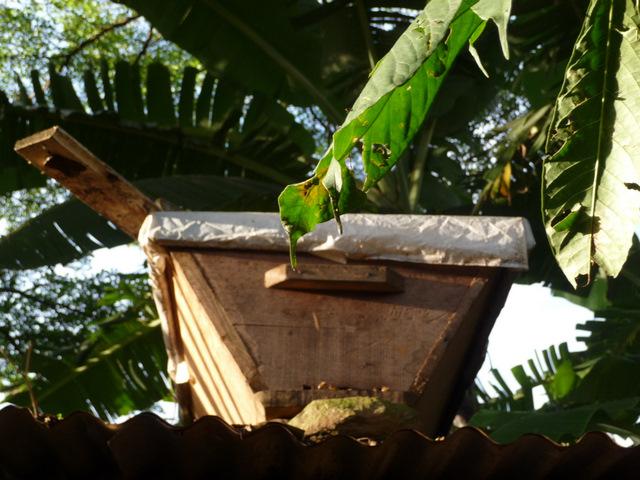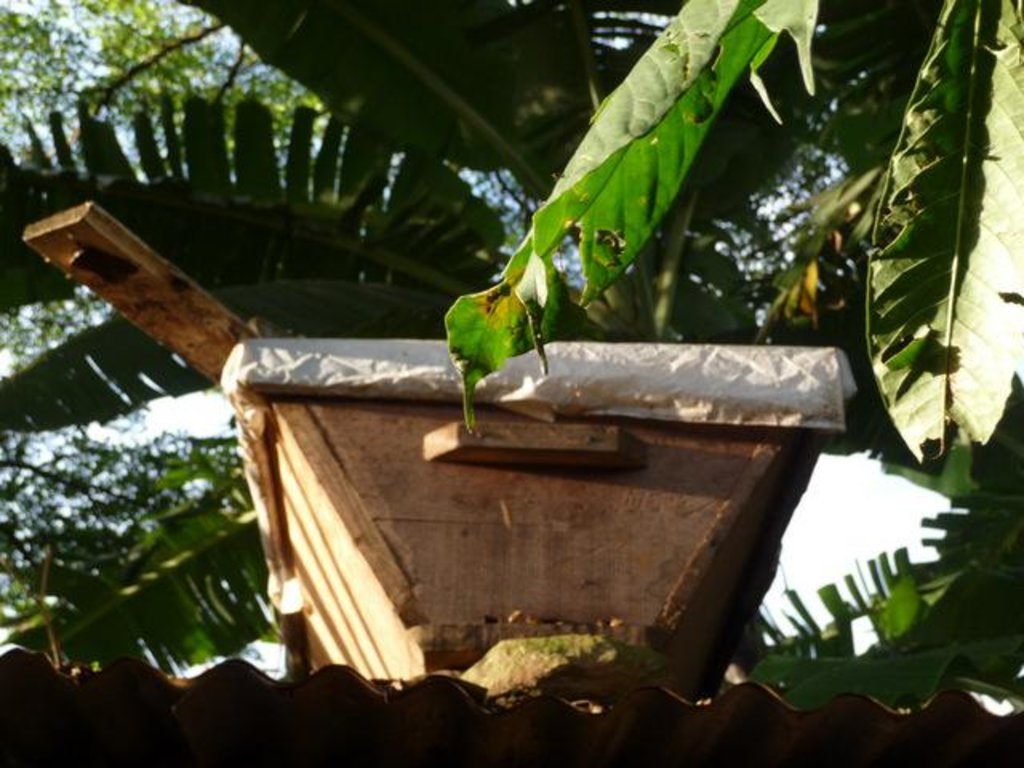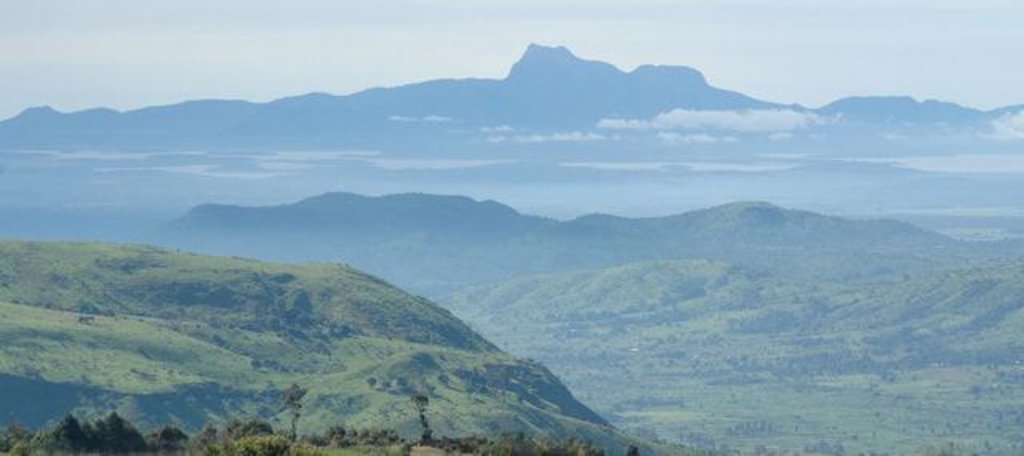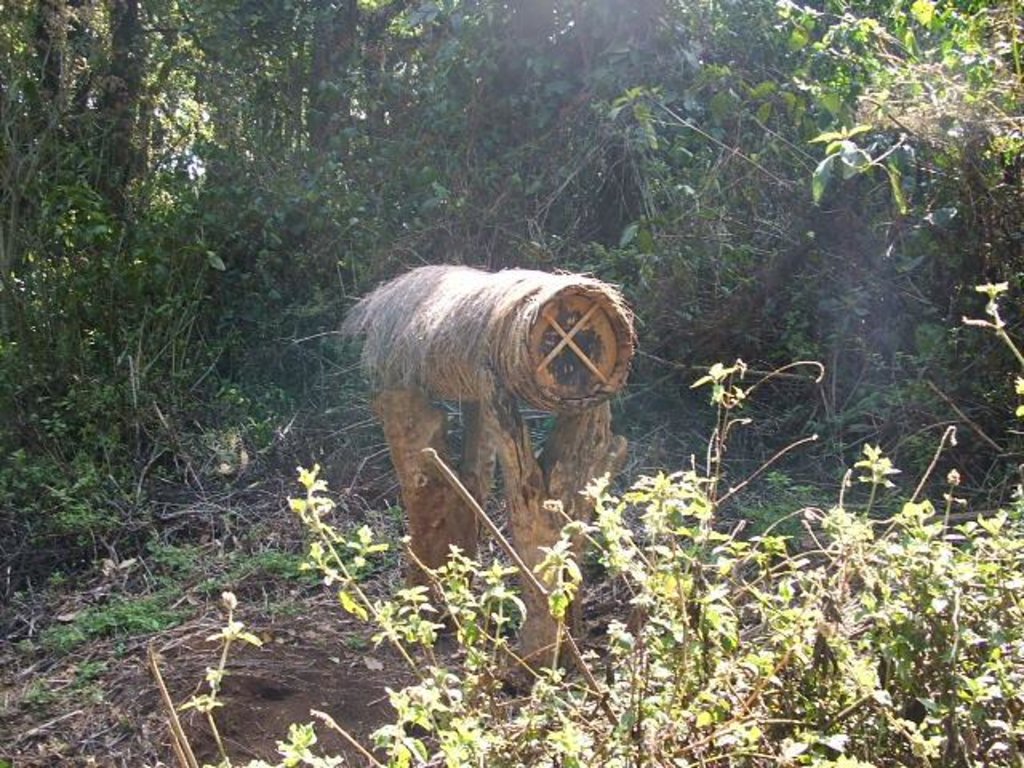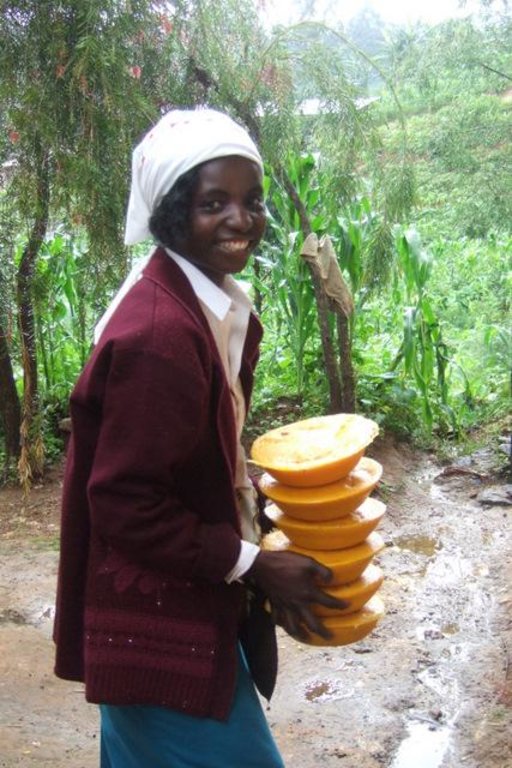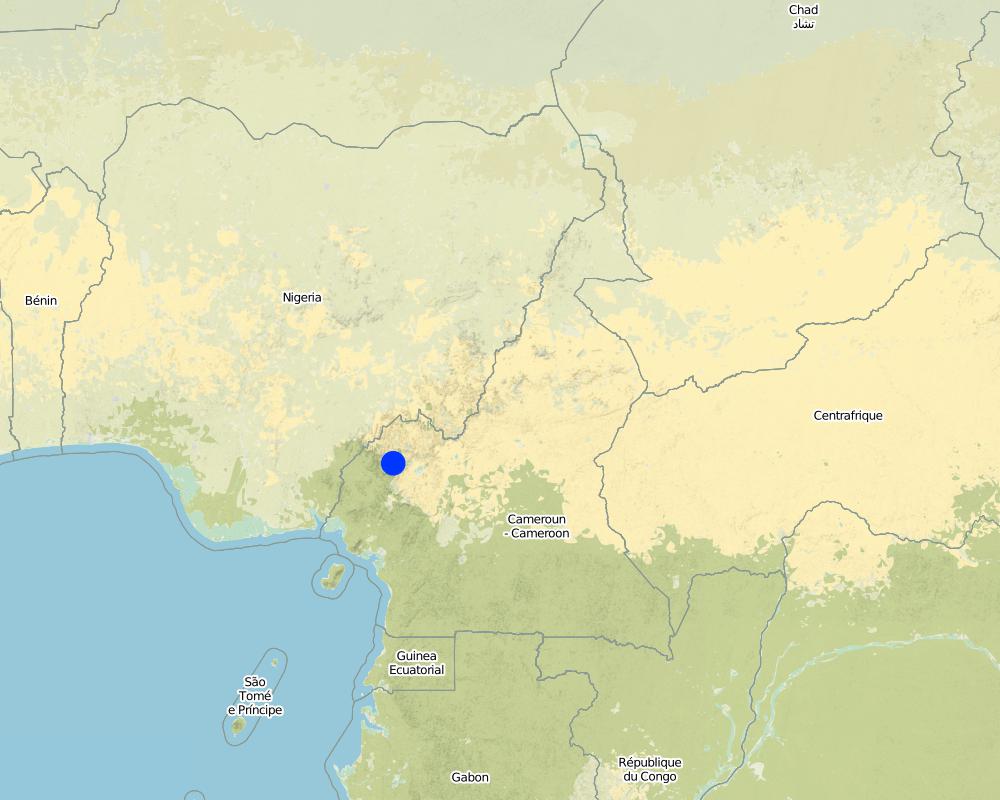Forest Beekeeping [แคเมอรูน]
- ผู้สร้างสรรค์:
- การอัพเดท:
- ผู้รวบรวม: Unknown User
- ผู้เรียบเรียง: –
- ผู้ตรวจสอบ: Fabian Ottiger, Alexandra Gavilano
technologies_1360 - แคเมอรูน
ดูส่วนย่อย
ขยายทั้งหมด ย่อทั้งหมด1. ข้อมูลทั่วไป
1.2 รายละเอียดที่ติดต่อได้ของผู้รวบรวมและองค์กรที่เกี่ยวข้องในการประเมินและการจัดเตรียมทำเอกสารของเทคโนโลยี
วิทยากรหลัก
ผู้เชี่ยวชาญ SLM:
Verina Ingram
Cifor Cameroon
แคเมอรูน
ชื่อของโครงการซึ่งอำนวยความสะดวกในการทำเอกสารหรือการประเมินเทคโนโลยี (ถ้าเกี่ยวข้อง)
Book project: SLM in Practice - Guidelines and Best Practices for Sub-Saharan Africa (SLM in Practice)ชื่อขององค์กรซึ่งอำนวยความสะดวกในการทำเอกสารหรือการประเมินเทคโนโลยี (ถ้าเกี่ยวข้อง)
CIFOR Center for International Forestry Research (CIFOR) - อินเดีย1.3 เงื่อนไขการใช้ข้อมูลที่ได้บันทึกผ่านทาง WOCAT
ผู้รวบรวมและวิทยากรหลักยอมรับเงื่อนไขเกี่ยวกับการใช้ข้อมูลที่ถูกบันทึกผ่านทาง WOCAT:
ใช่
1.5 Reference to Questionnaire(s) on SLM Approaches (documented using WOCAT)
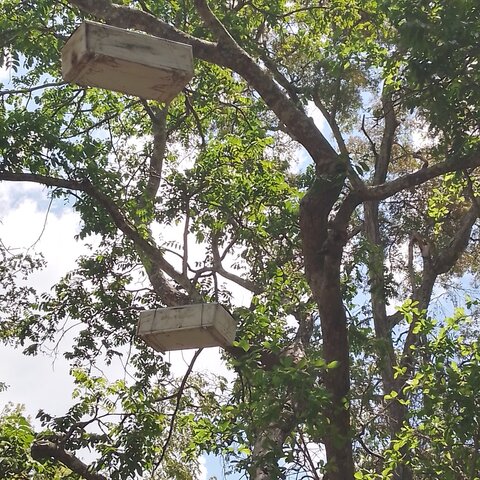
BEEKEEPING FOR CONSERVATION OF NATURAL TREES AND FOREST … [แทนซาเนีย]
Beekeeping is an activity which involves maintenance of bee colonies by using man-made hives within a selected forest area which provides the required feed and habitat resources required by bees. Through beekeeping, trees are conserved as they provide flowers hence ensuring feeds for bees. Beekeeping is used as an approach …
- ผู้รวบรวม: LINDA SHIO
2. การอธิบายลักษณะของเทคโนโลยี SLM
2.1 การอธิบายแบบสั้น ๆ ของเทคโนโลยี
คำจำกัดความของเทคโนโลยี:
Apiculture (beekeeping) is a traditional practice providing a high number of non-timber forest products.
2.2 การอธิบายแบบละเอียดของเทคโนโลยี
คำอธิบาย:
Apiculture (beekeeping) has been traditionally practiced for at least a century in Cameroon; with forest-based apiculture increasing in the last 2 decades. The ancient art of honey hunting, and the more recent apiculture and its products like honey, wax, propolis, bee venom and royal jelly, are examples of non-timber forest products (NTFP). A number of projects were supporting production and marketing, due to the conservation and development benefits of beekeeping. Beekeeping has low establishment costs and requires little land or labour, and by providing a suitable environment for the hives in a favourable location (i.e. forest with a range of melliferous trees and plants and sufficient water available year round) it is possible to sustainably harvest a range of bee products on an annual basis. For processing of the honey, the honeycomb is filtered and honey can be bottled and sold. Higher value is obtained by packaging and labelling. In Cameroon up to 4 US$/kg can be achieved for good quality honey. It can also be sold for industrial use – for example bakeries, sweets. If combs are washed, the resulting honey-water can be made into wine. Wax needs to be melted and cleaned, and can then be sold ‘raw’ for a price of about 2-6 US$/kg, or further processed into candles, soaps and creams. In Cameroon, the consumer market is expanding and a small, niche export market for high quality, certified organic and fair trade wax, honey and propolis, is emerging. The exports to Europe and the US require quality assurance schemes that entail costs, expertise and collaboration between government and beekeepers. The number of hives per bee-farmer can vary considerably from a few up to 150 hives. Approximately 15 hives can be installed per hectare. Beekeepers can be good ‘guardians of the forests’, because they know that the forest provides both forage and water for the bees, and the water and materials needed to make hives and process apiculture products.
2.3 รูปภาพของเทคโนโลยี
2.5 ประเทศภูมิภาค หรือสถานที่ตั้งที่เทคโนโลยีได้นำไปใช้และได้รับการครอบคลุมโดยการประเมินนี้
ประเทศ:
แคเมอรูน
ภูมิภาค/รัฐ/จังหวัด:
Mount Oku region, Mountainous forests of Northwest Cameroon
ข้อมูลจำเพาะเพิ่มเติมของสถานที่ตั้ง :
Bui, Boyo, Mezam and Donga Mantung divisions
Map
×2.6 วันที่การดำเนินการ
ถ้าไม่รู้ปีที่แน่นอน ให้ระบุวันที่โดยประมาณ:
- มากกว่า 50 ปี (แบบดั้งเดิม)
2.7 คำแนะนำของเทคโนโลยี
ให้ระบุว่าเทคโนโลยีถูกแนะนำเข้ามาอย่างไร:
- เป็นส่วนหนึ่งของระบบแบบดั้งเดิมที่ทำก้นอยู่ (> 50 ปี)
3. การจัดประเภทของเทคโนโลยี SLM
3.1 วัตถุประสงค์หลักของเทคโนโลยี
- สร้างผลกระทบทางด้านเศรษฐกิจที่เป็นประโยชน์
3.2 ประเภทของการใช้ที่ดินในปัจจุบันที่ได้นำเทคโนโลยีไปใช้

ป่า/พื้นที่ทำไม้
- Sustainable rainforest management
ผลิตภัณฑ์และบริการ:
- ผลไม้และถั่ว
- ผลิตภัณฑ์อื่น ๆ จากป่า
แสดงความคิดเห็น:
Apiculture (beekeeping)
Major land use problems (land users’ perception): Deforestation, Overuse of natural ressources
3.5 กลุ่ม SLM ที่ตรงกับเทคโนโลยีนี้
- การเลี้ยงผึ้ง การเพาะเลี้ยงสัตว์น้ำ สัตว์ปีก ฟาร์มกระต่าย ฟาร์มหนอนไหม
3.6 มาตรการ SLM ที่ประกอบกันเป็นเทคโนโลยี

มาตรการอนุรักษ์ด้วยการจัดการ
- M3: การวางผังตามสิ่งแวดล้อมทางธรรมชาติและสิ่งแวดล้อมของมนุษย์
แสดงความคิดเห็น:
Main measures: management measures
3.7 รูปแบบหลักของการเสื่อมโทรมของที่ดินที่ได้รับการแก้ไขโดยเทคโนโลยี

การเสื่อมโทรมของดินทางด้านชีวภาพ
- Bc (Reduction of vegetation cover): การลดลงของจำนวนพืชที่ปกคลุมดิน
แสดงความคิดเห็น:
Main type of degradation addressed: Bc: reduction of vegetation cover
Main causes of degradation: deforestation / removal of natural vegetation (incl. forest fires), over-exploitation of vegetation for domestic use
3.8 การป้องกัน การลดลง หรือการฟื้นฟูความเสื่อมโทรมของที่ดิน
ระบุเป้าหมายของเทคโนโลยีกับความเสื่อมโทรมของที่ดิน:
- ป้องกันความเสื่อมโทรมของที่ดิน
4. ข้อมูลจำเพาะด้านเทคนิค กิจกรรมการนำไปปฏิบัติใช้ ปัจจัยนำเข้า และค่าใช้จ่าย
4.1 แบบแปลนทางเทคนิคของเทคโนโลยี
ข้อมูลจำเพาะด้านเทคนิค (แบบแปลนทางเทคนิคของเทคโนโลยี):
Technical knowledge required for field staff / advisors: moderate
Technical knowledge required for land users: low
Main technical functions: Indirectly deforestation / overuse of natural forests
Layout change according to natural and human environment
4.3 กิจกรรมเพื่อการจัดตั้ง
| กิจกรรม | Timing (season) | |
|---|---|---|
| 1. | Construction of hives (traditional or modern, depending on skills and availability/ cost of materials) | |
| 2. | Place hives on forest trees or on stands, above the level of fires, as well as away from ant and termite colonies | |
| 3. | None |
แสดงความคิดเห็น:
Establishing activities: extra information Harvesting of honey combs often done at night to minimize disturbance of the bees Comb washing water can be used in honey beer or wine in lidded buckets / basins or bottles or using as fermentation airlock
4.4 ค่าใช้จ่ายของปัจจัยนำเข้าที่จำเป็นสำหรับการจัดตั้ง
| ปัจจัยนำเข้า | หน่วย | ปริมาณ | ค่าใช้จ่ายต่อหน่วย | ค่าใช้จ่ายทั้งหมดต่อปัจจัยนำเข้า | %ของค่าใช้จ่ายที่ก่อให้เกิดขึ้นโดยผู้ใช้ที่ดิน | |
|---|---|---|---|---|---|---|
| แรงงาน | Labour | ha | 1.0 | 40.0 | 40.0 | 100.0 |
| อุปกรณ์ | Tools | ha | 1.0 | 10.0 | 10.0 | |
| อุปกรณ์ | Smoker | ha | 1.0 | 15.0 | 15.0 | |
| อุปกรณ์ | Buckets | ha | 1.0 | 12.0 | 12.0 | |
| อุปกรณ์ | Filtering materials | ha | 1.0 | 10.0 | 10.0 | |
| อุปกรณ์ | Bottles | ha | 1.0 | 10.0 | 10.0 | |
| วัสดุสำหรับก่อสร้าง | Replacement/repair hive, filte | ha | 1.0 | 15.0 | 15.0 | |
| ค่าใช้จ่ายทั้งหมดของการจัดตั้งเทคโนโลยี | 112.0 | |||||
| Total costs for establishment of the Technology in USD | 112.0 | |||||
4.5 การบำรุงรักษาสภาพหรือกิจกรรมที่เกิดขึ้นเป็นประจำ
| กิจกรรม | ช่วงระยะเวลา/ความถี่ | |
|---|---|---|
| 1. | Wait for natural colonisation or capture a swarm and transfer to hive | |
| 2. | Regular (weekly or monthly) checking of hive conditions to ensure that the colony is not disturbed by pests or damaged through wind/ rain. In drought periods a shallow bucket of water is provided to the bees. Reparation activities if needed. | |
| 3. | Harvest honey (as soon as sufficient is available), wax and propolis, using a 'smoker' and clean bucket, leaving brood combs to maintain the colony (usually annually at end of rainy and/or flowering season; depends on location) | |
| 4. | Filter honey from combs to separate honey and wax; then bottle and pack | |
| 5. | Process wax (e.g. washing comb and boiling in water or solar melting box) and melt into moulds, using a press or centrifuge. |
4.6 ค่าใช้จ่ายของปัจจัยนำเข้าและกิจกรรมที่เกิดขึ้นเป็นประจำที่ต้องการการบำรุงรักษา (ต่อปี)
| ปัจจัยนำเข้า | หน่วย | ปริมาณ | ค่าใช้จ่ายต่อหน่วย | ค่าใช้จ่ายทั้งหมดต่อปัจจัยนำเข้า | %ของค่าใช้จ่ายที่ก่อให้เกิดขึ้นโดยผู้ใช้ที่ดิน | |
|---|---|---|---|---|---|---|
| แรงงาน | Labour | ha | 1.0 | 60.0 | 60.0 | 100.0 |
| วัสดุสำหรับก่อสร้าง | Replacement/repair hive, filte | ha | 1.0 | 5.0 | 5.0 | 100.0 |
| ค่าใช้จ่ายทั้งหมดของการบำรุงรักษาสภาพเทคโนโลยี | 65.0 | |||||
| Total costs for maintenance of the Technology in USD | 65.0 | |||||
แสดงความคิดเห็น:
Machinery/ tools: machete, axe, knife
5. สิ่งแวดล้อมทางธรรมชาติและของมนุษย์
5.1 ภูมิอากาศ
ฝนประจำปี
- < 250 ม.ม.
- 251-500 ม.ม.
- 501-750 ม.ม.
- 751-1,000 ม.ม.
- 1,001-1,500 ม.ม.
- 1,501-2,000 ม.ม.
- 2,001-3,000 ม.ม.
- 3,001-4,000 ม.ม.
- > 4,000 ม.ม.
ข้อมูลจำเพาะ/ความคิดเห็นเรื่องปริมาณน้ำฝน:
2000-2400
เขตภูมิอากาศเกษตร
- กึ่งชุ่มชื้น
Thermal climate class: tropics
5.2 สภาพภูมิประเทศ
ค่าเฉลี่ยความลาดชัน:
- ราบเรียบ (0-2%)
- ลาดที่ไม่ชัน (3-5%)
- ปานกลาง (6-10%)
- เป็นลูกคลื่น (11-15%)
- เป็นเนิน (16-30%)
- ชัน (31-60%)
- ชันมาก (>60%)
ธรณีสัณฐาน:
- ที่ราบสูง/ที่ราบ
- สันเขา
- ไหล่เขา
- ไหล่เนินเขา
- ตีนเนิน
- หุบเขา
ระดับความสูง:
- 0-100 เมตร
- 101-500 เมตร
- 501-1,000 เมตร
- 1,001-1,500 เมตร
- 1,501-2,000 เมตร
- 2,001-2,500 เมตร
- 2,501-3,000 เมตร
- 3,001-4,000 เมตร
- > 4,000 เมตร
ความคิดเห็นและข้อมูลจำเพาะเพิ่มเติมเรื่องสภาพภูมิประเทศ:
Altitudinal zone: 1501-2000 m a.s.l. (Mountain forests)
Landforms: Also valley floors
5.3 ดิน
ค่าเฉลี่ยความลึกของดิน:
- ตื้นมาก (0-20 ซ.ม.)
- ตื้น (21-50 ซ.ม.)
- ลึกปานกลาง (51-80 ซ.ม.)
- ลึก (81-120 ซ.ม.)
- ลึกมาก (>120 ซ.ม.)
เนื้อดิน (ดินชั้นบน):
- ละเอียด/หนัก (ดินเหนียว)
(ถ้ามี) ให้แนบคำอธิบายเรื่องดินแบบเต็มหรือระบุข้อมูลที่มีอยู่ เช่น ชนิดของดิน ค่า pH ของดินหรือความเป็นกรดของดิน ความสามารถในการแลกเปลี่ยนประจุบวก ไนโตรเจน ความเค็ม เป็นต้น:
Soil texture: FIne/heavy (lateritic clay)
5.5 ความหลากหลายทางชีวภาพ
ความหลากหลายทางชนิดพันธุ์:
- สูง
5.6 ลักษณะของผู้ใช้ที่ดินที่นำเทคโนโลยีไปปฏิบัติใช้
แนวทางการตลาดของระบบการผลิต:
- mixed (subsistence/ commercial)
ระบุลักษณะอื่นๆที่เกี่ยวข้องของผู้ใช้ที่ดิน:
Difference in the involvement of women and men: small to medium scale, very poor to average level of wealth; individuals, groups cooperative or employee; cooperatives are mainly used for marketing products and/ or buying material
Population density: 50-100 persons/km2
Relative level of wealth: average, poor, very poor
5.8 กรรมสิทธิ์ในที่ดิน สิทธิในการใช้ที่ดินและสิทธิในการใช้น้ำ
สิทธิในการใช้ที่ดิน:
- เกี่ยวกับชุมชน (ถูกจัดระเบียบ)
แสดงความคิดเห็น:
Land ownership: community forest or individual (titled and not titled)
Land use rights: legal form of community management; many people keep bees by the forest edge on their farms, usually on privately owned land
Land ownership: communal / village, individual, not titled, individual, titled
6. ผลกระทบและสรุปคำบอกกล่าว
6.1 ผลกระทบในพื้นที่ดำเนินการ (On-site) จากการใช้เทคโนโลยี
ผลกระทบทางด้านเศรษฐกิจและสังคม
รายได้และค่าใช้จ่าย
รายได้จากฟาร์ม
แสดงความคิดเห็น/ระบุ:
Increased income from honey, wax and propolis sales
ผลกระทบด้านสังคมวัฒนธรรมอื่น ๆ
ความมั่นคงด้านอาหาร / พึ่งตนเองได้
แสดงความคิดเห็น/ระบุ:
Subsistence use and sales of apiculture products e.g. wax / honey / propolis soaps, cosmetic, creams
สถานการณ์ด้านสุขภาพ
แสดงความคิดเห็น/ระบุ:
Own consumption of honey food and medicine and propolis (medicinal use)
ผลกระทบด้านนิเวศวิทยา
ความหลากหลายทางชีวภาพของพืชและสัตว์
การปกคลุมด้วยพืช
แสดงความคิดเห็น/ระบุ:
Conservation of forests and particularly melliferous trees as well as pollination of forests and crops
มวลชีวภาพ/เหนือดินชั้น C
แสดงความคิดเห็น/ระบุ:
Conservation of forests and particularly melliferous trees as well as pollination of forests and crops
ความหลากหลายทางชีวภาพของพืช
แสดงความคิดเห็น/ระบุ:
Conservation of forests and particularly melliferous trees as well as pollination of forests and crops
ชนิดพันธุ์ที่ให้ประโยชน์
6.2 ผลกระทบนอกพื้นที่ดำเนินการ (Off-site) จากการใช้เทคโนโลยี
Pollination
แสดงความคิดเห็น/ระบุ:
Pollination in area approx 4-6 km from hive
6.3 การเผชิญและความตอบสนองของเทคโนโลยีต่อการเปลี่ยนแปลงสภาพภูมิอากาศที่ค่อยเป็นค่อยไป และสภาพรุนแรงของภูมิอากาศ / ภัยพิบัติ (ที่รับรู้ได้โดยผู้ใช้ที่ดิน)
แสดงความคิดเห็น:
Unknown sensitivity of bees to climatic extremes; resilience of bees is assumed, but changes in honey quality and quantity depending on forage available with changes in forest cover/ structure
6.4 การวิเคราะห์ค่าใช้จ่ายและผลประโยชน์ที่ได้รับ
ผลประโยชน์ที่ได้รับเปรียบเทียบกับค่าใช้จ่ายในการจัดตั้งเป็นอย่างไร (จากมุมมองของผู้ใช้ที่ดิน)
ผลตอบแทนระยะสั้น:
ด้านลบเล็กน้อย
ผลตอบแทนระยะยาว:
ด้านบวก
ผลประโยชน์ที่ได้รับเปรียบเทียบกับค่าใช้จ่ายในการบำรุงรักษาหรือต้นทุนที่เกิดขึ้นซ้ำอีก เป็นอย่างไร (จากมุมมองของผู้ใช้ที่ดิน)
ผลตอบแทนระยะสั้น:
เป็นกลางหรือสมดุล
ผลตอบแทนระยะยาว:
ด้านบวก
แสดงความคิดเห็น:
Initial investment in hives often recouped in 2-5 years, depending on level of production
6.5 การปรับตัวของเทคโนโลยี
ถ้ามีข้อมูลให้บอกปริมาณด้วย (จำนวนของครัวเรือนหรือครอบคลุมพื้นที่):
4500 households and 100% of the area covered
Of all those who have adopted the Technology, how many did so spontaneously, i.e. without receiving any material incentives/ payments?
- 91-100%
แสดงความคิดเห็น:
100% of land user families have adopted the Technology without any external material support
4500 land user families have adopted the Technology without any external material support
There is a strong trend towards spontaneous adoption of the Technology
Comments on adoption trend: Established and knowledgeable beekeepers in a community aid dissemination of technology and spontaneous adoption.
6.7 จุดแข็ง / ข้อได้เปรียบ / โอกาสของเทคโนโลยี
| จุดแข็ง / ข้อได้เปรียบ / โอกาสในทัศนคติของผู้รวบรวมหรือวิทยากรหลัก |
|---|
| Protection of the forest because beekeepers are aware of the benefits they receive from this ecosystem |
6.8 จุดอ่อน / ข้อเสียเปรียบ / ความเสี่ยงของเทคโนโลยีและวิธีการแก้ไข
| จุดอ่อน / ข้อเสียเปรียบ / ความเสี่ยงในทัศนคติของผู้ใช้ที่ดิน | มีวิธีการแก้ไขได้อย่างไร |
|---|---|
| Pests destroy hives / eat honey (e.g. honey badgers, ants, termites, civets) | relocate hives, stronger/ different hive construction, regular checks |
| Theft of hives | patrol forest, make agreements in community, locate hives near farms/houses, chain or lock hive. |
| Low production | relocate hives to more forested areas, ensure hive located with < 2 km from water source in dry season |
| Bush fires can destroy hive | agreements with farmers/pastoralists about bush fire patrols in dry season, create fire breaks around hive and support trees |
| Rain can destroy hive | use of metal, sheet, grass, raffia or wood as protective ‘roof’, place in a ‘’bee house’’ of locally constructed materials, or under a simple shelter, and experiment with different designs |
ลิงก์และโมดูล
ขยายทั้งหมด ย่อทั้งหมดลิงก์

BEEKEEPING FOR CONSERVATION OF NATURAL TREES AND FOREST … [แทนซาเนีย]
Beekeeping is an activity which involves maintenance of bee colonies by using man-made hives within a selected forest area which provides the required feed and habitat resources required by bees. Through beekeeping, trees are conserved as they provide flowers hence ensuring feeds for bees. Beekeeping is used as an approach …
- ผู้รวบรวม: LINDA SHIO
โมดูล
ไม่มีโมดูล


